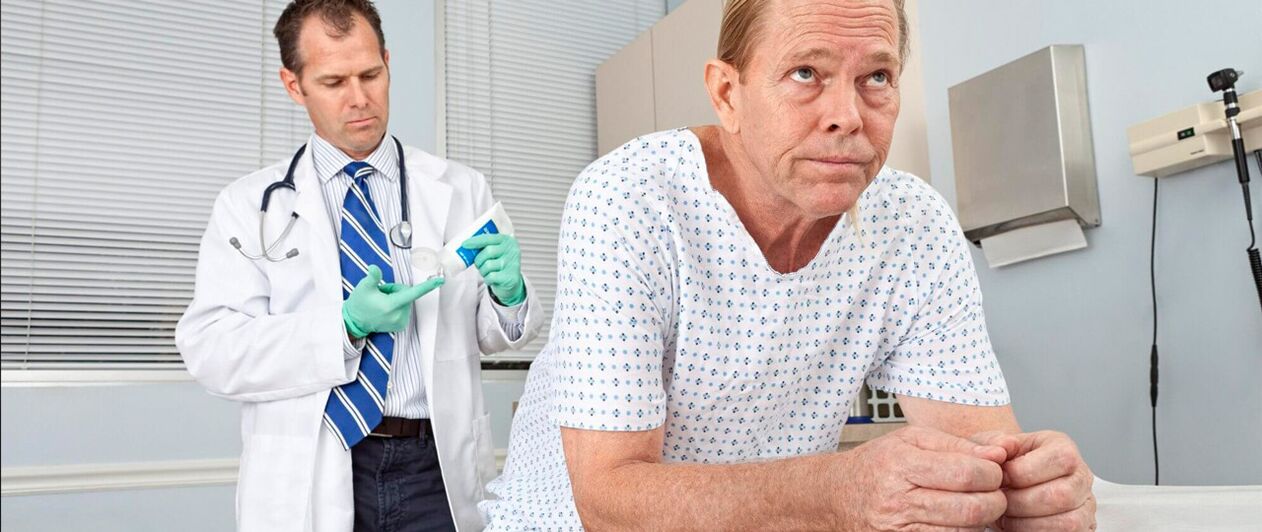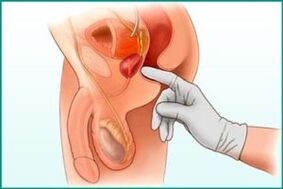
About half of male patients visiting the urologist suffer from chronic prostate. Problems caused by a specific pathology exacerbate the quality of life, lead to depression and mental disorders.However, a clear understanding of the functions of the prostate gland and the mechanism of development of inflammation allow us to accurately determine the symptoms and cure the disease in a timely manner.
The meaning of the term "prostatitis"
With this term, it is customary to understand the development of the inflammatory process in the tissues of the prostate gland.Since it is present only in the male body, the disease is common between this category of population.Its main function is the development of a specific fluid, which is included in the following processes:
- forms and supports a certain environment in the urethra;
- dilutes the sperm;
- ensures sperm stability;
- Protects the genitourinary system from infection.
Under the influence of a number of factors, secretion of secrecy slows, which in itself becomes a violation.Prostate epithelium cells deserve periodically, but due to jams are not excreted but accumulated, forming microlytes - small pebbles.Covered by the mucosa, they block the glandular ducts, leading to the formation of small abscesses.During this period, the body still continues to function normally, negative external manifestations are missing.
Progress of the process (accumulation of dense formations, an increase in concentration of purulent contents) leads to an increase in the organ and the compression of the ureter, blood vessels and nerve endings.This is one of the causes of the disease.
Symptoms of the disease based on patient complaints
Already at the stage described above, the first signs are manifested, which a man cannot notice.Based on these changes, you can independently identify the development of home inflammation.Of course, such a diagnosis is indicative, but it is considered a serious reason to contact a specialist.
Self -diagnosis at home
What are the first signs of prostate in men?
Difficult urine emergence.Compression of the urethral canal increased in size from prostate tissue leads to its narrowing and, as a result, to prevent urine flow.The patient should apply a certain effort during urination.
Distant production of urine.Calls to empty the bladder are becoming more frequent.At first, this happens at night, later during the day.Seeing it in an extra tea cup, the man continues to ignore the violations.
Pain in the lower abdomen.The symptom is a consequence of microlyte accumulation.The sensations become uncomfortable and are crushed, attracting or exploding painful.From the evening or after physical exercise, their growth may occur.
Violations of lifting and spilling.The syndrome occurs against the backdrop of stale phenomena and rarely occurs.By directing this to fatigue and stress, the patient also ignores this sign.
Often the patient complains of a general deterioration in the condition, an increase in body temperature, which is also a sign of a developmental process.
The first signs of prostate in men require treatment, otherwise the process will go to an extended form.
Symptoms of acute inflammation
The appearance of the prostate lies in the fact that, without characteristic manifestations at first, it begins a sharp and rapid development, but then quickly chronic.

In order not to lose the moment and start timely treatment, a clear idea of the symptoms of acute form is needed.
- Fever, chills.
- An increase in body temperature to critical values (39 ° C).
- Severe pain in the perineum, lumbar and inguinal region.
- Disordishes of urination - frequent and false stimulation, a difficult urine flow or its temporary interruption.
- Significant intoxication - headache, weakness, pain in the joints and muscles, tachycardia.
- Transparent or white discharge from the urethra.
Examination of the rectal finger becomes impossible due to the formation of pain syndrome.Moreover, it is contraindicated, as there may be a distribution (spread) of the blood flow and the development of sepsis in the process of examination.
Manifestations of chronic relap
In a slow form, pathological processes of different types of disease can occur.However, based on patient complaints and diagnostic data, experts distinguish the following signs of chronic prostate of general order:
- Discomfort, moderate pain in the claws, radiating in the sacrum, lower spine, scrotum, weakness and pain in the body.
- Severity and tires in the urinary canal during sexual intercourse or urination.Presence of purulent-seer discharge from the urethra.
- Frequent urination, accompanied by a feeling of incomplete emptying at the end of the process.
- The inability to fertilize associated with the lack of sperm mobility, their accumulation or an increase in the acidity of the secret.
- Violation of spill (premature or, conversely, prolonged), pain or sensation deleted with orgasm.

Types of disease and simultaneous signs
Urologists distinguish several stages of chronic inflammation of the gland, each of which corresponds to certain manifestations.
A characteristic feature for all species is a moderate pain syndrome on the pelvic floor.
| The form of prostate | Symptoms |
|---|---|
| Chronic bacterial | Dysuria, premature spill |
| Pedal pain syndrome | Lack of other manifestations other than pain |
| inflammatory | Expressed problems with urination, embarrassment in the genitals |
| Stagnant | In some cases, dysuria, discomfort |
| Asymptomatic | No clinical manifestations |
Diagnosis
The doctor can already determine the presence of prostate inflammation during a man's first visit.However, it is possible to determine the etiology, phase and complexity only with the help of instrumental and laboratory research.
Primary examination of the doctor
The history of anamnesis is a patient study and the analysis of external symptoms is one of the important stages of the diagnosis.During the conversation, the doctor determines the presence of clinical signs and the cause of the development of the pathological process.Here, the patient's lifestyle, bad habits, the use of contraceptive methods and the presence of a sexual partner are important.At the same time, it draws attention to the possibility of existing diseases of close relatives and inherited predisposition.
The next step is an examination of the rectal finger of the prostate gland. Palpation is performed to determine parameters such as:
Palpation is performed to determine parameters such as:
- organ size;
- structures and contours;
- the presence of seals;
- pain
Laboratory
The next step is to perform analysis.This category is quite wide, so only one urologist determines the need for each of them.
Oam khrateustizes the overall condition of the urinary system organs. The increased content of red blood cells, leukocytes and proteins, as well as the presence of mucus and other impurities, indicates a wide course of the inflammatory process.
Urethra stain is a painful and unpleasant procedure, which, however, allows you to determine the presence of infection and create its variety.
Bacteriological planting of urine allows you to identify the localization of the lesion, a variety of infection and the type of pathogen.
The cytological analysis of the seed fluid is performed to determine its physico -chemical properties, mobility, activity and sperm concentration, as well as the dog level.The biomaterial fence is performed directly in the laboratory after the prostate massage.
The state of the procedure is sexual abstinence during the day.In case of suspicion of chronic processing, this type of study is performed systematically.
Symptoms discovered using instrumental diagnostic methods
Hardware methods are recognized as the most effective, which is due to obtaining accurate and detailed information about the physical characteristics of the prostate gland and alleged pathological changes in its tissues.They significantly facilitated the work of doctors.
Of all the variety of species, as a rule, only an ultrasound study is made, and the rest of the methods are used if it is necessary to obtain additional results.
Ultrasound is performed to visualize the gland and determine its general condition, size, consistency.The transactive method is considered more informative - trustees.A special sensor is inserted into the rectum, which allows you to determine what the organ looks like, identify tumors, adhesions, calculations, calcins, cystic formations and other pathological deviations.
MRI is described to determine the type of prostate and more clarifying the depth of the results previously obtained, especially if some details remained unclear.
Urofloometry determines the speed of urine current, time to achieve its maximum value, volume of urine.Performed using a special device.
Cystoscopy with a thin probe makes it possible to evaluate the condition of the bladder and urethra canal, as well as identify the alleged and existing pathological changes.
Biopsy is performed in case of suspicion of the oncological nature of the disease in order to exclude it.
The risks of the asymptomatic flow of the disease
Prostatitis, which has no symptoms, develops in patients of the older age group.

The reasons for her appearance are:
- frequent hypothermia;
- Constipation and hypodynamia;
- weakened immunity;
- decrease in sexual activity;
- The presence of chronic pathologies.
Provocative factors are:
- The age of a man;
- decreased hormone production;
- Weakening prostate protective functions
- Degenerative processes in its fabrics.
Lack of treatment due to the inability to detect timely the disease involves the occurrence of such consequences:
- Constant erectile dysfunction;
- prostate tissue fibrosis;
- development of kidney and liver failure;
- urolithiasis;
- Benign hyperplasia of the prostate gland, adenoma, cancer.
Looking for a premature doctor: complications
The risk of prostatitis lies in its rapid transition into a chronic form with greasy symptoms and lack of an expressed clinical photography, as in an acute course.
This form may not manifest for a long period of time, which leads to irreversible processes in the gland tissue and different types of complications:
- vesicular, posterior urethritis;
- prostate abscess;
- glandular tissue sclerosis and eryprical duct obstruction;
- polycist formations;
- Development of a calculative form;
- powerlessness and infertility, problems with conception;
- Urinary system pathologies - cystitis, pyelonephritis, urolithiasis;
- Disordishes nerve-psychogenic-psychogenic disorders, prolonged depression, decreased self-esteem.
Way to ease the patient's condition
The characteristics of the choice of therapeutic tactics depend on the type of disease, the form of origin, the flow features.
Symptomatic treatment
The acute manifestations of the disease are extremely painful for the patient.Therefore, the priority task is to eliminate them.For this, medication treatment is used.With prostatitis, medicines are prescribed to men depending on severe symptoms:
- Antibacterial drugs to eliminate the pathogen.
- Diuretics are medicines to stabilize bladder work in order to improve urine flow.
- Analgesics - to eliminate the pain in the head, joints and muscles.
- Antispasmodics and alpha-1-adrenal vessels-for relaxing smooth muscles.
An effective form of dosage is considered to be the rectum suppositor.Candles are used to relieve acute symptoms:
- With an antibiotic that eliminates painful cramps and fights infectious manifestations.
- With NSAIDs, flattening inflammatory processes.
- Analgesic with analgesic, which improve blood microcirculation and restore the normal state of the prostate.
Eliminate the cause of inflammation
After stopping acute symptoms, it is necessary to start the therapy of the main manifestations.Treatment in this case is aimed at eliminating infection and restoring blood circulation.The following groups of medicines are used for the following purposes:
- antibiotics in tablets;
- anti -inflammatory drugs;
- Immunomodulators;
- Phytopparations.
If acute manifestations are missing but signs of prostate in men are preserved, the patient continues to treat physiotherapy, traditional medicine (pumpkin seeds, ginger and other medicines), alternative methods (treatment with caterpillars, bee bakeries, manual therapy).A positive result is often achieved only after proper energy correction.
Prevention of primary prostatitis and symptoms of irritation of a chronic form
Modern medicine successfully faces the elimination of the prostate, despite the long period of treatment.
For men who transferred an acute or barely recovered form by chronic current, it is important to respect preventive measures:
- Change of Life of Life:
- regular walks;
- active sports;
- Rejecting bad habits.
- Restoring normal sexual behavior:
- Choosing a reliable partner;
- rejection of occasional links;
- regular sexual intercourse;
- Protected sex.
- Compliance with a diet:
- rejection of fatty, fried, spicy foods;
- Use of healthy and natural products.
- Preventive examination by a doctor:
- Regular - once every six months - exams;
- passing a course of support therapy;
- Performing gymnastics exercises.
In modern conditions of life, inflammation of the prostate gland is not a sentence.Despite the severity and complexity of the current, a variety of clinical species, the disease can be treated perfectly.However, to avoid the dangerous consequences and developing serious complications, it is necessary to contact specialists in a timely manner.And for that you need to know all the traits of signs and symptoms of prostate.























